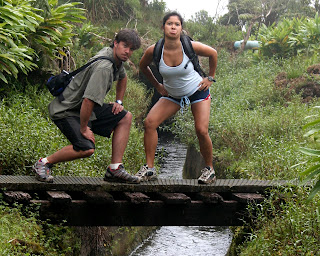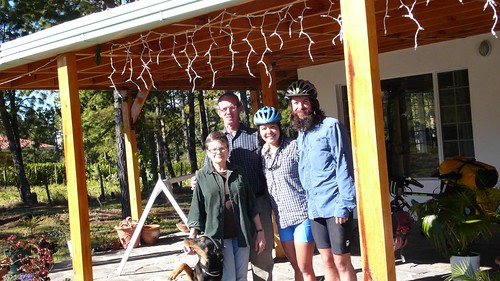
After the Los Quetzales hike, we set off on leg #2 of our Panama journey- cycling the Azuero Peninsula. We decided shortly after entering Panama that we wouldn't ride to Panama City because the only route there would require hundreds of kilometers of riding on the highway. So, we'd do sections of riding and sections of backpacking/ bus riding to get to the city. We set off from Paso Ancho all loaded up, waving goodbye to Craig and Dana, headed for David (the second biggest city in Panama) where we caught a bus with our bikes to the Azuero Peninsula. The ride to David was about 65 km and down, down, downhill. We pedaled for maybe 3 km max. Although the ride wasn't physically challenging, we didn't survive it without any pain.

Just 4 km or so from David, Leah ate it hard. We had just started riding on the shoulder (vs riding in the far right lane) because traffic was increasing going into David, but the shoulder wasn't all paved...as it appeared. I was coasting down a little hill at a good clip when all of a sudden, the pavement ended and turned to relatively deep sand (the same color as the pavement, making it hard to see the pavement ended). I was able to control my bike from skidding out, but as soon as I got through it, I turned around to warn Leah, as I knew she'd have trouble. It was too late. As I whipped my head around, I caught the last glimpse of her losing control and then splat...a mishmash of bike, panniers, and Leah (thankfully whole) was on the ground. She survived with a bit of road-rash and bruising to her right thigh and some cuts on her right elbow. She suffered the usual post traumatic shakes and slight nausea but was able to get up and get moving soon. And once again, we were graced with typical Panamanian generosity as two separate cars pulled over to make sure Leah was okay and offer assistance in the short time we waited on the side of the road for Leah to gain her bearings. We pulled over in David for Leah to wash clean and dress her wounds. I tried to help her but being the nurse she is she insisted on doing most of the work while I helped as much as allowed and documented the action on camera.
We rolled into the bus station, found a bus headed in the direction we were going, loaded up our stuff and arrived in Divisa (the town at the junction to the road into the Azuero peninsula) a few hours later. It was nearing dark by the time we started riding, so at the first
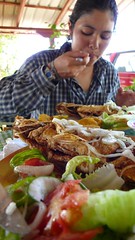
house that looked promising we tried our luck in asking for a place to stay. The owner of the house was a man named Lambert Baxter who's father was Jamaican and mother was English and they had come to work on the canal.
Through our time in Panama it became apparent that this sort of mixed and unusual background is quite common among the Panamanian people.
For such a small country it really has a varied population due to the canal. The next day we topped our previous distance record with a 115 km ride to Pedasi. The road was a little narrow, but the traffic wasn't too bad and we made it in decent time even with our stops to gorge on some tasty watermelon and scrumptious fried fish. Near the end of the day though, I definitely lost my appetite when we passed a slaughterhouse and the aromas of burning and rotting cow flesh filled my nose. I tried holding my breath as we passed but that's a bit difficult to do while trying to bike.
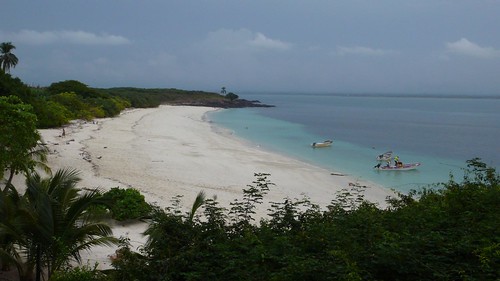
One of the main attractions around Pedasi (at the tip of the peninsula) is Iguana Island, about 30 minutes by small boat from the mainland. Luckily, two other couples at our hotel had found a fisherman to take them out the next day and we were able to tag along and split the cost. As we approached the island, we noticed the air above was dotted with specks. Finally the specks took shape and they turned out to be hundreds of frigate birds soaring above the island. We had a relaxing day watching the birds, snorkeling, wandering the short trails, playing with hermit crabs and looking at iguanas.
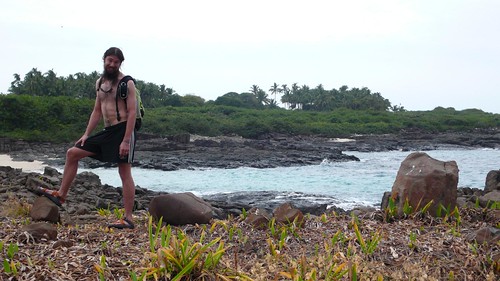
The next day after we had packed up and were about to head out, a Panamanian couple, Alex & Marta Pinzon, stopped to talk to us. They were vacationing in Pedasi as well and lived in Penonome, a few hours drive away. They introduced us to their two sons, Chicho (biological son) and Peter, an exchange student from Maryland. Peter is a biker himself and told us that he had actually seen us a couple days before riding through another town on our way to Pedasi. His account of seeing us went something like this, "We were at the town square when I saw this crazy looking guy with all this hair and sunglasses riding down the street. I wanted to talk to you both and tried to yell to you but you didn't hear me."
After chatting for a short while, Marta and Alex gave us their contact information and told us to get a hold of them if we ever were coming through Penonome (which we did later in the trip).
Shortly after leaving Pedasi, we got caught in a torrential downpour. It started with some sprinkles, but as it got heavier, instinctively, our shoulders started to hunch up and our heads tilt down as if it would keep us dry. Finally, it was coming down with such force that not a square inch on our bodies was dry. Almost simultaneously, Leah and I both came to the revelation that, hey, hunching up and cringing isn't doing us any good, we're already soaked to the bone, we aren't cold, and actually, this is really fun. We both threw our faces skyward, relaxed our shoulders and started laughing, whooping and hollering. All the people we passed who were of course taking cover under a roof must have though we were two loco gringos.
That night we stopped in Guera (a very little town north of Tonosi) to camp for the night. We introduced ourselves to a farmer to ask if we could camp in his yard and all got a laugh when Leah introduced herself and he then he introduced himself. His name was Elia :). He thought we'd have more space to camp at his brother's house across the street so he took us over and
introduced us to Rigo who was happy to let us stay. We met Rigo's wife and two daughters spent the rest of the evening chatting away, testing each other's Spanish and English skills, and learning about the surrounding area.
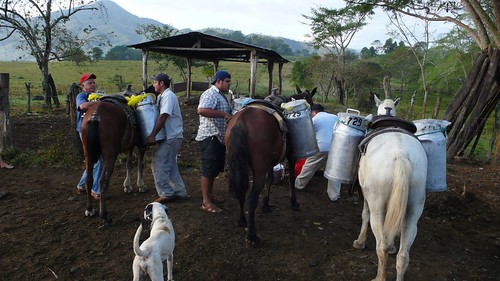
Rigo and Elia were dairy farmers (like pretty much all of the people in the area) and every morning, the two of them, Elia's son, and another man milk 60 cows by hand (this explained their killer handshakes when we introduced ourselves). The next morning, the girls took us down to the corral where they were hard at work and already almost done by 7:30. Their method - simple yet ingenious. They would tie up the cow's calf so the cow would move, tie the cows feet up so it couldn't kick, sit down on their one legged, hands free stool that hung from their belt and milk the cow, about 10-12 minutes for each cow.
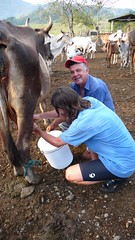
They would then pour the frothy milk through a strainer into stainless steel milk jugs (like the ones from way back in the day). When all the cows had been milked they would let them out to graze (that's right, grass fed beef in these parts), load the milk jugs onto their horses and take them out to the road (after taking a little for themselves). There are two dairy companies that come around and take the milk back to be processed.
Consequently as you ride down the road in these parts there are always stainless steel milk jugs in front of almost every house, it is almost like stepping back in time. Rigo and his wife shared some tortillas and orange juice before we departed. It was our first time tasting Panamanian tortillas and boy were they delicious. They are unlike any other country's tortillas thus far- thick, small, made with fresh corn and flour and deep fried. Like a little fried corn cake...mmmmmm.
The day's ride consisted of some rolling hills and eventually a gradual descent into Chitre where we spent the next couple nights. Chitre is a small city but the downtown is bustling with activity. Leah and I stopped at the Herrera museum (Chitre is the capital of the Herrera province). As we wandered around, Victor, the museum guide tagged along and explained the exhibits, asked us about life in the US and talked to us about life in Panama.
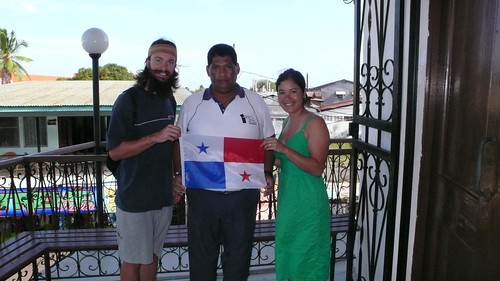
Later, he excused himself for a moment and came back with a Panama flag as a gift for Leah and I. We expressed some interest in buying some local art and he told us the best place for that was La Arena, a town only 5 minutes away on bus. He insisted on taking us to the bus stop, waiting for the bus with us and then asking the driver to tell us wehre to get off. The amiability of the people we have met while traveling down here never ceases to amaze us.
Probably my favorite thing that we did during our two nights in Chitre was going to the corner
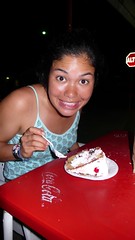
where there was a bakery and batido (milkshake) shop next to each other. We went after almost every meal. The bakery had amazing cakes but specialized in these buttery, braided biscuit ringlets about three inches in diameter. They baked them fresh all day long. This caused the street in front of the bakery to be filled with an alluring aroma which I had actually smelled when we passed by on our bikes while looking for a hotel. The batido shop had every kind of fruit available and therefore every kind of batido imaginable. There were so many options I never could bear to have the same one twice.
It came time to leave Chitre and head back to David. We made plans to participate in a paseo, a 100 mile bike ride from David to Las Lajas and back along the Pan-American highway, with Craig, our Paso Ancho host and his cycling team, The Mountain Kings. It was easy to find a bus to take us to Divisa no problem, but getting from Divisa to David on a Saturday proved to be a little more difficult (and even MORE difficult with bikes). Every bus going in that direction was full and didn't even stop at the bus stop. I decided to take matters into my own hands and solve the problem creatively. There was a police check point about 100 yards away from the bus stop so I walked over to ask drivers (with room in the beds of their trucks) if they were headed in our direction. I of course asked the cops if it was okay, they said
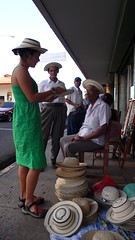
no problem, but we would have more luck if Leah came over there and did the asking (not to mention they would benefit from her presence as well). The checkpoint seemed like it was just a way to kill time for the cops as all they would do is take the license of the driver, sometimes look at it, maybe crack a joke to the driver, and send them off. The cop also told me that he was trying to sell his father's car which happened to be parked conveniently next to the check point where everyone could take a look at it. I eventually found a truck that took us to the main bus stop in Santiago where it would be much easier to find a bus going to David. We loaded up our bikes, said thanks to the cops and took off with the wind in our hair in the back of the truck. After asking every truck and bus that pulled into the bus station in Santiago (for three hours nonetheless) we finally found a bus that had room for our bikes, bags and us and we made it to David in the early evening, the day before the paseo. An early morning and LONG day of riding awaited us.


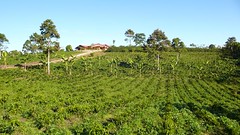

 After tackling only a few hills the next day, we stopped at a scenic point to admire Volcan Baru right in front of us (the tallest mountain in Panama, about 12,000 ft). We had been there only a few minutes and Roberto, the boss, pulled over in his truck. He offered us a ride to Volcan, 15 km away, and we accepted (and in so doing changed the entire course of the rest of our trip, through lucky coincidences). He was a great tour guide and stopped at a waterfall,
After tackling only a few hills the next day, we stopped at a scenic point to admire Volcan Baru right in front of us (the tallest mountain in Panama, about 12,000 ft). We had been there only a few minutes and Roberto, the boss, pulled over in his truck. He offered us a ride to Volcan, 15 km away, and we accepted (and in so doing changed the entire course of the rest of our trip, through lucky coincidences). He was a great tour guide and stopped at a waterfall, 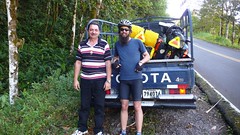
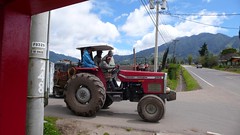

 Earlier in the day, David went to take a short morning ride and before he could even get started, he rolled his bike backward to get it out of its spot and completely bent and broke his rear derailer. Our first big mechanical failure. Thus, David rode to Paso Ancho on a single speed and we bought a used rear derailer from Javier the following day that he happened to have lying around. Craig and his wife, Dana, kindly invited us to stay at their house for the night and we basked in the comfort of a home, bed, kitchen, and friendly company. The New Years eve party was at Fernando and Claudette´s house, Craig and Dana´s friends that live down the street. We arrived at 8 and spent the next 5 hours chatting with some very interesting and kind folks from all over the place who now live in the area. The assortment included a Columbian businessman, jolly Dutchman, American canal-zoners, birders galore, Obama fans, and retirees exploring their life's passions. Also included were Angel and Carla Rodriguez, two ex-Seattleites who used to own R&E Cycles over in the U-District. Angel is actually the "R" in R&E Cycles and is the founder of Rodriguez Cycles (custom cycles sold at R&E). Small world. Our olfactory glands and taste buds were reinvigorated as we dined on an elaborate meal accompanied by delicious wine and midnight champagne. No PB and J tonight :). The night ended with a bit of dancing and lots of gratitude for a great time. Just the morning prior, I was mourning the fact that we were going to have an uneventful New Years eve and probably be sleeping by 8. So glad I was mistaken.
Earlier in the day, David went to take a short morning ride and before he could even get started, he rolled his bike backward to get it out of its spot and completely bent and broke his rear derailer. Our first big mechanical failure. Thus, David rode to Paso Ancho on a single speed and we bought a used rear derailer from Javier the following day that he happened to have lying around. Craig and his wife, Dana, kindly invited us to stay at their house for the night and we basked in the comfort of a home, bed, kitchen, and friendly company. The New Years eve party was at Fernando and Claudette´s house, Craig and Dana´s friends that live down the street. We arrived at 8 and spent the next 5 hours chatting with some very interesting and kind folks from all over the place who now live in the area. The assortment included a Columbian businessman, jolly Dutchman, American canal-zoners, birders galore, Obama fans, and retirees exploring their life's passions. Also included were Angel and Carla Rodriguez, two ex-Seattleites who used to own R&E Cycles over in the U-District. Angel is actually the "R" in R&E Cycles and is the founder of Rodriguez Cycles (custom cycles sold at R&E). Small world. Our olfactory glands and taste buds were reinvigorated as we dined on an elaborate meal accompanied by delicious wine and midnight champagne. No PB and J tonight :). The night ended with a bit of dancing and lots of gratitude for a great time. Just the morning prior, I was mourning the fact that we were going to have an uneventful New Years eve and probably be sleeping by 8. So glad I was mistaken.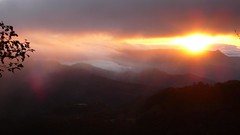 We skirted around the mountain (rather than go over it) hoping to see a Quetzal (very beautiful and elusive bird) along the way. The trail was closed secondary to mudslides from the floods a few weeks prior, but we turned a blind eye to the sign and kept on as there were no rangers to shoo us away. About half way to Boquete, there was a little wooden lookout a few hundred meters from the trail that provided an amazing view of the canopy below and surrounding mountains. It became our camp spot for the night and from there were were able to experience a spectacular sunrise over the mountains in the morning.
We skirted around the mountain (rather than go over it) hoping to see a Quetzal (very beautiful and elusive bird) along the way. The trail was closed secondary to mudslides from the floods a few weeks prior, but we turned a blind eye to the sign and kept on as there were no rangers to shoo us away. About half way to Boquete, there was a little wooden lookout a few hundred meters from the trail that provided an amazing view of the canopy below and surrounding mountains. It became our camp spot for the night and from there were were able to experience a spectacular sunrise over the mountains in the morning. 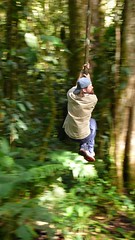 The trail wasn´t washed out too bad, but we did have to contort ourselves a bit to get through some root and rock messes and also get creative to cross a couple of rivers. Unfortunately, no Quetzales decided to grace us with their presence, but we did see quite a few other colorful and chirpy birds. When we exited the trail, there was a ranger at the other side who told us that the Quetzales are up higher on the mountain at this time of year and don´t come down until March, oh well. He was very nice and thankfully didn´t chastise us for hiking the trail illegally. We then hopped on a bus all stinky and muddy and made it back to Paso Ancho where our bikes and stuff were (at Craig and Dana´s house). That night we shared stories with Craig and Dana over a delicious meal and slept well, prepared for another leg of our bike tour to commence the following day.
The trail wasn´t washed out too bad, but we did have to contort ourselves a bit to get through some root and rock messes and also get creative to cross a couple of rivers. Unfortunately, no Quetzales decided to grace us with their presence, but we did see quite a few other colorful and chirpy birds. When we exited the trail, there was a ranger at the other side who told us that the Quetzales are up higher on the mountain at this time of year and don´t come down until March, oh well. He was very nice and thankfully didn´t chastise us for hiking the trail illegally. We then hopped on a bus all stinky and muddy and made it back to Paso Ancho where our bikes and stuff were (at Craig and Dana´s house). That night we shared stories with Craig and Dana over a delicious meal and slept well, prepared for another leg of our bike tour to commence the following day.